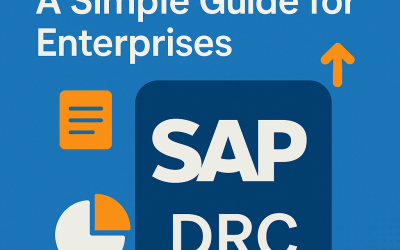In the rapidly evolving landscape of enterprise resource planning (ERP) systems, SAP S/4HANA has emerged as a game-changer. It is an intelligent, next-generation ERP suite built on the SAP HANA in-memory database, enabling businesses to streamline their operations, gain real-time insights, and stay ahead in today’s competitive business environment.
If your company is considering adopting SAP S/4HANA, this step-by-step guide will walk you through the implementation process and highlight the benefits of making this transition.
What is SAP S/4 HANA?
SAP S/4HANA is an advanced ERP solution that integrates various business functions like finance, sales, procurement, manufacturing, and more into a unified, digital core. It leverages the power of in-memory computing to process large volumes of data in real time, offering instant analytics, reporting, and actionable insights for smarter decision-making.
Implementing SAP S/4HANA can lead to several advantages for your business. It enables faster data processing, simplifies business processes, enhances productivity, supports predictive analytics, and enables better customer experiences. Real-time data availability empowers users to make data-driven decisions and adapt to market changes swiftly.
Why is proper implementation of SAP S/4HANA important for maximizing ROI?
A well-planned and executed SAP S/4HANA implementation is crucial for maximizing your return on investment (ROI). It ensures that the system aligns with your business needs, optimizes processes, minimizes disruptions, and reduces downtime during migration. A successful implementation lays a solid foundation for realizing the full potential of SAP S/4HANA and gaining a competitive edge in the market.
SAP S/4 HANA Implementation Methodology
Several implementation methodologies are available, such as SAP Activate, ASAP (Accelerated SAP), and Agile. Among these, SAP Activate is the recommended approach, as it combines Agile practices with SAP’s best practices. It emphasizes continuous testing, iterative improvements, and business user involvement throughout the implementation journey, leading to faster and more effective deployments.
SAP S4 HANA Implementation Phases & Their Importance
SAP S/4HANA implementation typically comprises the following phases:
- Preparation: Defining project scope, assembling the implementation team, and conducting feasibility studies.
- Discovery: Analyzing the existing system, identifying gaps, and determining required customizations.
- Design: Creating a blueprint for the new system, configuring processes, and integrating data sources.
- Realization: Building and testing the SAP S/4HANA system based on the design specifications.
- Final Preparation: Conduct end-to-end testing, data migration, and user training.
- Go-Live & Support: Deploying the system, monitoring performance, and providing post-implementation support.
Best practices include setting clear objectives, involving stakeholders early on, conducting comprehensive testing, and ensuring robust data cleansing and migration.
Best Practices for a successful SAP S/4HANA implementation
- Engage Business Users: Involve key business users from the start to understand their requirements and align the solution accordingly.
- Data Quality and Migration: Ensure data accuracy and perform thorough data migration to prevent issues during and after go-live.
- Change Management: Develop a change management strategy to prepare employees for the new system and address any resistance.
- Continuous Training: Provide ongoing training to users to maximize their proficiency and drive user adoption.
- Post-Implementation Support: Offer reliable support after go-live to address any issues promptly and keep the system running smoothly.
Step-by-Step SAP S/4HANA Implementation Process
SAP S/4HANA Implementation Process in detail, in step-by-step format:
Step 1 – Conduct a feasibility study and create a business case for SAP S/4HANA adoption.
Step 2 – Assemble a cross-functional implementation team.
Step 3 – Define the scope, objectives, and timelines for the project.
Step 4 – Conduct a thorough assessment of existing systems and processes.
Step 5 – Develop a detailed implementation plan and strategy.
Step 6 – Configure the SAP S/4HANA system based on business requirements.
Step 7 – Perform extensive testing to validate the system’s functionality.
Step 8 – Migrate data from the legacy system to SAP S/4HANA.
Step 9 – Provide comprehensive training to end-users.
Step 10 – Deploy the system in a controlled environment and conduct a final check.
Go live with the new SAP S/4HANA system and monitor its performance. Offer post-implementation support and continuous improvement.
SAP S/4 HANA Implementation Costs and Factors Influencing It
SAP S/4HANA implementation involves licensing and subscription costs based on the number of users and features required. Additionally, companies need to invest in high-performance hardware and infrastructure to support the in-memory computing capabilities. Third-party services and consulting costs vary depending on the complexity of the implementation, customization needs, and the level of support required.
Why Companies Need SAP S/4 HANA?
SAP S/4HANA empowers businesses with advanced forecasting capabilities, enabling them to analyze historical data, predict market trends, and make informed decisions. The real-time insights provided by the system contribute to accurate revenue forecasting, helping businesses identify potential growth opportunities and stay ahead of the competition.
Adopting SAP S/4HANA through a tech-savvy and hassle-free implementation ensures smooth operations, minimal disruptions, and faster time-to-value. This approach allows companies to quickly leverage the benefits of the system, stay agile in a dynamic market, and achieve a higher ROI.
In conclusion, SAP S/4HANA is a powerful ERP solution that can revolutionize the way businesses operate. Implementing it with a well-structured plan, involving stakeholders, and following best practices is key to realizing its full potential and gaining a competitive edge in the market.
FAQs About SAP S4HANA Implementation
What is S4 Hana implementation?
SAP S/4HANA implementation is the process of deploying and integrating the SAP S/4HANA ERP suite into an organization’s existing infrastructure. It involves planning, configuring, testing, and migrating data to the new system to streamline business processes and leverage real-time insights.
What are the phases of SAP S4 Hana implementation?
6 SAP S/4HANA Implementation Phases:
- Preparation: Defining project scope, assembling the team, and conducting feasibility studies.
- Discovery: Analyzing existing systems, identifying gaps, and determining customization needs.
- Design: Creating a blueprint, configuring processes, and integrating data sources.
- Realization: Building and testing the system based on design specifications.
- Final Preparation: Conduct end-to-end testing, data migration, and user training.
- Go-Live & Support: Deploying the system and providing post-implementation support.
Why implement SAP S4 Hana?
SAP S/4HANA offers real-time analytics, simplifies processes, enhances productivity, and supports predictive decision-making. It enables businesses to stay agile, adapt to market changes, and deliver better customer experiences. The intelligent suite empowers users with instant insights, driving data-driven strategies for growth and success.
What is Hana full form?
SAP HANA stands for “Systems, Applications, and Products in Data Processing – High-Performance Analytic Appliance. SAP HANA is an innovative technology that combines in-memory computing with advanced analytics, allowing organizations to process vast amounts of data quickly and perform real-time analyses.
Is SAP S4HANA cloud-based?
Yes, SAP S/4HANA is available as an on-premise solution and as a cloud-based offering (SAP S/4HANA Cloud, Rise with HANA & Grow with HANA). The cloud version provides a scalable, cost-effective, and faster implementation option for businesses looking to avoid infrastructure management.
Where can I find the best SAP S/4HANA Consultants?
Our team of highly skilled and certified SAP consultants can provide the expertise and guidance you need. From planning and design to seamless integration and post-implementation support, we’ve got you covered.
With our customer-centric approach and proven implementation methodology, we ensure a smooth and hassle-free experience. Our consultants will work closely with your team to tailor solutions that align perfectly with your unique business needs.
Don’t miss this opportunity to unlock the full potential of our SAP S/4HANA Services. Let’s discuss how our consultants can make a real difference for your business.




0 Comments